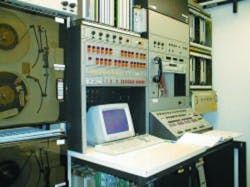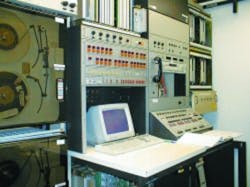The Electronic Repair Division (ERS) at Verizon Logistics, formerly known as GTE Communications Systems, comprises several support lines of business. One of the key services is voice line-card or plain old telephone service (POTS) repair for internal Verizon and outside commercial telco businesses.
When line cards fail, the carrier is very concerned with uptime. As a result, the actual repair generally is farmed out to operations such as Verizon. Because of the number of manufacturers and the variety of revisions of any single line-card model (many of these line cards will be in service for more than 20 years), functional test is the method of choice for test and diagnosis.
Telecom depot repair operations have a different set of functional test requirements than a manufacturing operation. Numerous factors make up the test criteria including a fault spectrum derived from the field environment, FCC quality standards, 99.9% uptime requirements, and the quality standards of the customers.
The first generation of functional testing at ERS used the actual telephony central office (CO) switches for a hot-bed test environment. This was very costly in terms of hardware, labor, and maintenance requirements. The costs were further increased because the switch had to be configured to emulate all the environments throughout Verizon’s network.
The most costly aspect was the complete setup for each telephony switch, such as Nortel, Lucent, or Siemens, that Verizon ERS needed to support. The environment for the POTS line card was fully replicated, enabling testing of all the features and capabilities of the POTS line cards. Also, the card’s resultant functional test and repair results had to be manually entered into a database for analysis of Verizon’s line-reliability status.
The second generation of functional testing evolved from applying a rack-and-stack (R&S) test-bed methodology, which segregated the testing into functional-test and system-test areas. Implementing the R&S functional test increased the first-pass yield at system test to more than 95%. In addition, it decreased cumulative test time on the POTS line cards.
The R&S system also was computer controlled and aided in automating the test process and datalogging. The efficiencies gained by the higher first-pass yields at the switch-system test level supported a higher volume of POTS line-card repairs. The corresponding throughput required an increase in the number of R&S systems to support the functional testing and repair requirements; however, this second-generation system did reduce overall labor costs.
The R&S system solution had some drawbacks. One resulted from the one-off nature where the software sometimes varied from tester to tester. Also, R&S equipment interoperability periodically caused problems. This happened in cases where the instruments and drivers were for different revisions of the same model. Lastly, the functional testers had to be manned 100% of the time to intervene when periodic instrument lockups occurred.
The New Approach
The third-generation test platform is a VXI-based functional ATE platform. This platform, the GenRad Geneva, is tailored for POTS line-card and telecom testing. The Geneva tester gave Verizon a more defined framework for test instrumentation and development software at a reduced capital-equipment cost.
This test platform provided a common test bed that could be deployed in all the major depot locations throughout the United States. The implementation supported faster test development times, reusable test-code modules, flexible user-customizable test flow, telecom test routines, and datalogging in a programmer- and operator-friendly environment.
The VXI instrumentation was more predictable and faster than the GPIB instruments. The VXI framework also enabled the Geneva to use ATE-style fixturing for interfacing the cards, making it easier to bring newer POTS line-card tests online.
The Geneva VXI platform also supported simultaneous multiple board testing. This increased the functional test throughput and reduced the per-card test and repair labor. Datalogging also was performed automatically throughout the test cycle.
Maintenance costs were reduced due to the simplified nature of the VXI platform vs. the R&S systems. The reduced cabling, self-test software, readily available parts, and simplified interfacing schemes decreased the support variables and enabled quicker servicing times.
After more than five years of using Geneva testers, the Verizon repair operations report a significant reduction in repair costs. The POTS line card tests have a 10-fold throughput increase over R&S testers and a 25-fold throughput increase over the pure system test.
Additionally, the test comprehensiveness and accuracy availed by the VXI platforms and Geneva scanner interface have enabled Verizon to progress to a functional test methodology where the Geneva performs 100% testing and system tests are conducted only on a sampling basis while still meeting the 99.9% good-quality requirement. This also has given us the confidence to drop a system-level test from our strategy and ship line cards directly to the customer from the functional test platform.
Our capital-equipment expenditures reduced significantly by using a common VXI-based platform like the Geneva. Verizon could divert repairs to other Geneva-equipped depot repair centers to handle peak volume demands and use that center’s excess capacity. The repeatability and accuracy of the systems helped decrease the capital expenditures made in the past to handle these peak demands.
Conclusion
The implementation of the VXI-based Geneva supported the requirements for telephony’s high level of test comprehensiveness while simultaneously reducing the costs of ownership and labor within Verizon’s POTS line-card repair operations. In addition, Verizon presently is enhancing its VXI-based equipment to support testing and repair of digital subscriber line (DSL) and other emerging telephony and data technologies.
Click here for the VXI Telecom Test Platform chart.
About the Author
David Helfrich is the national account manager at Verizon Logistics ERS. He has more than 20 years experience beginning with eight years at Texas Instruments test-engineering departments, first in the commercial division and later at the Harm Missile System Division. Mr. Helfrich spent another eight years at GenRad, and at the time this article was written, he was market response manager in the ERS group. Verizon Logistics ERS, 5615 High Pointe Dr. HQA04G02, Irving, TX 75038, 972-751-6537, e-mail: [email protected].
Return to EE Home Page
Published by EE-Evaluation Engineering
All contents © 2001 Nelson Publishing Inc.
No reprint, distribution, or reuse in any medium is permitted
without the express written consent of the publisher.
February 2001

